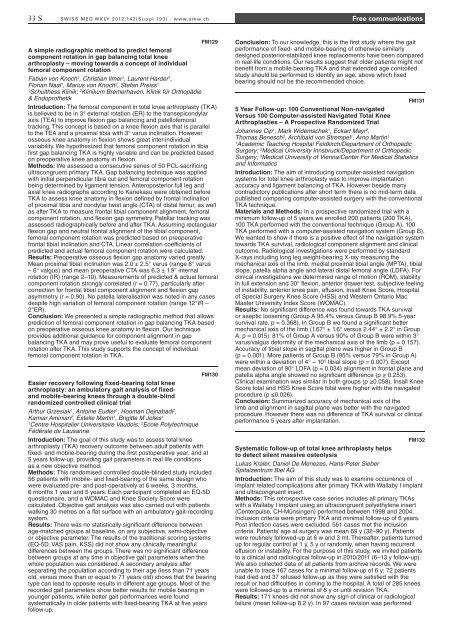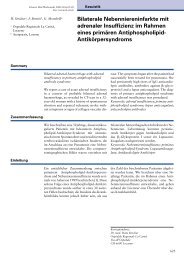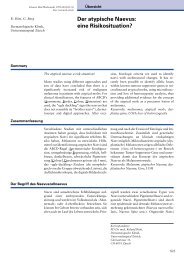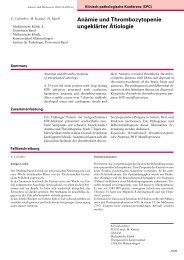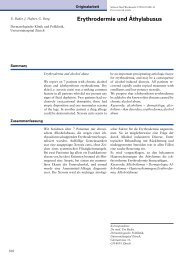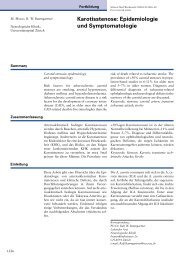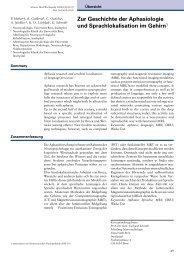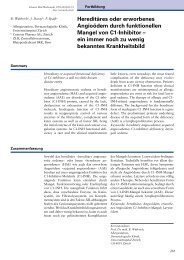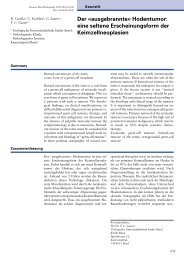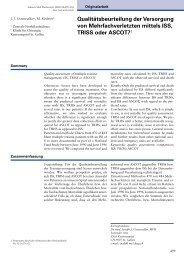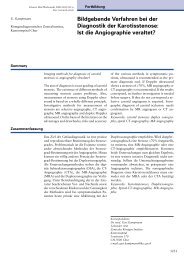SMW Supplementum 193 - Swiss Medical Weekly
SMW Supplementum 193 - Swiss Medical Weekly
SMW Supplementum 193 - Swiss Medical Weekly
You also want an ePaper? Increase the reach of your titles
YUMPU automatically turns print PDFs into web optimized ePapers that Google loves.
33 S SWiSS Med Wkly 2012;142(Suppl <strong>193</strong>) · www.smw.ch Free communications<br />
FM129<br />
A simple radiographic method to predict femoral<br />
component rotation in gap balancing total knee<br />
arthroplasty – moving towards a concept of individual<br />
femoral component rotation<br />
Fabian von Knoch1 , Christian Ilmer1 , Laurent Harder1 ,<br />
Florian Naal1 , Marius von Knoch2 , Stefan Preiss1 1Schulthess Klinik; 2Klinikum Bremerhaven, Klinik für Orthopädie<br />
& Endoprothetik<br />
Introduction: The femoral component in total knee arthroplasty (TKA)<br />
is believed to be in 3° external rotation (ER) to the transepicondylar<br />
axis (TEA) to improve flexion gap balancing and patellofemoral<br />
tracking. This concept is based on a knee flexion axis that is parallel<br />
to the TEA and a proximal tibia with 3° varus inclination. However<br />
osseous knee anatomy in flexion shows great inter-individual<br />
variability. We hypothesized that femoral component rotation in tibia<br />
first gap balancing TKA is highly variable and can be predicted based<br />
on preoperative knee anatomy in flexion.<br />
Methods: We assessed a consecutive series of 50 PCL-sacrificing<br />
ultracongruent primary TKA. Gap balancing technique was applied<br />
with initial perpendicular tibia cut and femoral component rotation<br />
being determined by ligament tension. Anteroposterior full leg and<br />
axial knee radiographs according to Kanekasu were obtained before<br />
TKA to assess knee anatomy in flexion defined by frontal inclination<br />
of proximal tibia and condylar twist angle (CTA) of distal femur, as well<br />
as after TKA to measure frontal tibial component alignment, femoral<br />
component rotation, and flexion gap symmetry. Patellar tracking was<br />
assessed radiographically before and after TKA. Assuming rectangular<br />
flexion gap and neutral frontal alignment of the tibial component,<br />
femoral component rotation was predicted based on preoperative<br />
frontal tibial inclination and CTA. Linear correlation coefficients of<br />
predicted and actual femoral component rotation were calculated.<br />
Results: Preoperative osseous flexion gap anatomy varied greatly.<br />
Mean proximal tibial inclination was 2.0 ± 2.5° varus (range 6° varus<br />
– 6° valgus) and mean preoperative CTA was 6.3 ± 1.9° internal<br />
rotation (IR) (range 2–10). Measurements of predicted & actual femoral<br />
component rotation strongly correlated (r = 0.77), particularly after<br />
correction for frontal tibial component alignment and flexion gap<br />
asymmetry (r = 0.90). No patella lateralisation was noted in any cases<br />
despite high variation of femoral component rotation (range 12°IR –<br />
2°ER).<br />
Conclusion: We presented a simple radiographic method that allows<br />
prediction of femoral component rotation in gap balancing TKA based<br />
on preoperative osseous knee anatomy in flexion. Our technique<br />
provides additional guidance for component alignment in gap<br />
balancing TKA and may prove useful to evaluate femoral component<br />
rotation after TKA. This study supports the concept of individual<br />
femoral component rotation in TKA.<br />
FM130<br />
Easier recovery following fixed-bearing total knee<br />
arthroplasty: an ambulatory gait analysis of fixedand<br />
mobile-bearing knees through a double-blind<br />
randomized controlled clinical trial<br />
Arthur Grzesiak1 , Antoine Eudier1 , Hooman Dejnabadi2 ,<br />
Kamiar Aminian2 , Estelle Martin1 , Brigitte M Jolles1 1Centre Hospitalier Universitaire Vaudois; 2Ecole Polytechnique<br />
Fédérale de Lausanne<br />
Introduction: The goal of this study was to assess total knee<br />
arthroplasty (TKA) recovery outcome between adult patients with<br />
fixed- and mobile-bearing during the first postoperative year, and at<br />
5 years follow-up, providing gait parameters in real life conditions<br />
as a new objective method.<br />
Methods: This randomised controlled double-blinded study included<br />
56 patients with mobile- and fixed-bearing of the same design who<br />
were evaluated pre- and post-operatively at 6 weeks, 3 months,<br />
6 months 1 year and 5 years. Each participant completed an EQ-5D<br />
questionnaire, and a WOMAC and Knee Society Score were<br />
calculated. Objective gait analysis was also carried out with patients<br />
walking 30 metres on a flat surface with an ambulatory gait-recording<br />
system.<br />
Results: There was no statistically significant difference between<br />
age-matched groups at baseline, on any subjective, semi-objective<br />
or objective parameter. The results of the traditional scoring systems<br />
(EQ-5D, VAS pain, KSS) did not show any clinically meaningful<br />
differences between the groups. There was no significant difference<br />
between groups at any time in objective gait parameters when the<br />
whole population was considered. A secondary analysis after<br />
separating the population according to their age (less than 71 years<br />
old, versus more than or equal to 71 years old) shows that the bearing<br />
type can lead to opposite results in different age groups. Most of the<br />
recorded gait parameters show better results for mobile bearing in<br />
younger patients, while better gait performances were found<br />
systematically in older patients with fixed-bearing TKA at five years<br />
follow-up.<br />
Conclusion: To our knowledge, this is the first study where the gait<br />
performance of fixed- and mobile-bearing of otherwise similarly<br />
designed posterior-stabilized knee replacements have been compared<br />
in real-life conditions. Our results suggest that older patients might not<br />
benefit from a mobile bearing TKA and that extended age controlled<br />
study should be performed to identify an age, above which fixed<br />
bearing should not be the recommended choice.<br />
FM131<br />
5 Year Follow-up: 100 Conventional Non-navigated<br />
Versus 100 Computer-assisted Navigated Total Knee<br />
Arthroplasties – A Prospective Randomized Trial<br />
Johannes Cip1 , Mark Widemschek1 , Eckart Mayr2 ,<br />
Thomas Benesch3 , Archibald von Strempel1 , Arno Martin1 1Academic Teaching Hospital Feldkirch/Department of Orthopedic<br />
Surgery; 2<strong>Medical</strong> University Innsbruck/Department of Orthopedic<br />
Surgery; 3<strong>Medical</strong> University of Vienna/Center For <strong>Medical</strong> Statistics<br />
and Informatics<br />
Introduction: The aim of introducing computer-assisted navigation<br />
systems for total knee arthroplasty was to improve implantation<br />
accuracy and ligament balancing of TKA. However beside many<br />
contradictory publications after short term there is no mid-term data<br />
published comparing computer-assisted surgery with the conventional<br />
TKA technique.<br />
Materials and Methods: In a prospective randomized trial with a<br />
minimum follow-up of 5 years we enrolled 200 patients (200 TKA),<br />
100 TKA performed with the conventional technique (Group A), 100<br />
TKA performed with a computer-assisted navigation system (Group B).<br />
We wanted to show if there is a positive effect of the navigation system<br />
towards TKA survival, radiological component alignment and clinical<br />
outcome. Radiological investigations were performed by standard<br />
X-rays including long leg weight-bearing X-ray measuring the<br />
mechanical axis of the limb, medial proximal tibial angle (MPTA), tibial<br />
slope, patella alpha angle and lateral distal femoral angle (LDFA). For<br />
clinical investigations we determined range of motion (ROM), stability<br />
in full extension and 30° flexion, anterior drawer test, subjective feeling<br />
of instability, anterior knee pain, effusion, Insall Knee Score, Hospital<br />
of Special Surgery Knee Score (HSS) and Western Ontario Mac<br />
Master University Index Score (WOMAC).<br />
Results: No significant difference was found towards TKA survival<br />
or aseptic loosening (Group A 95.4% versus Group B 98.9% 5-year<br />
survival rate, p = 0.368). In Group B we found a significant better<br />
mechanical axis of the limb (1.67° ± 1.6° versus 2.44° ± 2.2° in Group<br />
A; p = 0.015). 81% of Group A versus 90% of Group B were within 3°<br />
varus/valgus deformity of the mechanical axis of the limb (p = 0.157).<br />
Accuracy of tibial slope in sagittal plane was higher in Group B<br />
(p = 0.001). More patients of Group B (95% versus 79% in Group A)<br />
were within a deviation of 4° – 10° tibial slope (p = 0.007). Except<br />
mean deviation of 90° LDFA (p = 0.034) alignment in frontal plane and<br />
patella alpha angle showed no significant difference (p ≥ 0.253).<br />
Clinical examination was similar in both groups (p ≥0.058). Insall Knee<br />
Score total and HSS Knee Score total were higher with the navigated<br />
procedure (p ≤0.026).<br />
Conclusion: Summarized accuracy of mechanical axis of the<br />
limb and alignment in sagittal plane was better with the navigated<br />
procedure. However there was no difference of TKA survival or clinical<br />
performance 5 years after implantation.<br />
FM132<br />
Systematic follow-up of total knee arthroplasty helps<br />
to detect silent massive osteolysis<br />
Lukas Kraler, Daniel De Menezes, Hans-Peter Sieber<br />
Spitalzentrum Biel AG<br />
Introduction: The aim of this study was to examine occurrence of<br />
implant related complications after primary TKA with Wallaby I implant<br />
and ultracongruent insert.<br />
Methods: This retrospective case series includes all primary TKAs<br />
with a Wallaby I implant using an ultracongruent polyethylene insert<br />
(Centerpulse, CH-Münsingen) performed between 1998 and 2004.<br />
Inclusion criteria were primary TKA and minimal follow-up of 6 years.<br />
Post infection cases were excluded. 561 cases met the inclusion<br />
criteria. Patients’ age at surgery was mean 69 y (32–90 y). Patients<br />
were routinely followed-up at 6 w and 3 mt. Thereafter, patients turned<br />
up for regular control at 1 y, 5 y or randomly, when having recurrent<br />
effusion or instability. For the purpose of this study, we invited patients<br />
to a clinical and radiological follow-up in 2010/2011 (6–13 y follow-up).<br />
We also collected data of all patients from archive records. We were<br />
unable to trace 167 cases for a minimal follow-up of 6 y; 72 patients<br />
had died and 37 refused follow-up as they were satisfied with the<br />
result or had difficulties in coming to the hospital. A total of 285 knees<br />
were followed-up to a minimal of 6 y or until revision TKA.<br />
Results: 171 knees did not show any sign of clinical or radiological<br />
failure (mean follow-up 8.2 y). In 97 cases revision was performed


